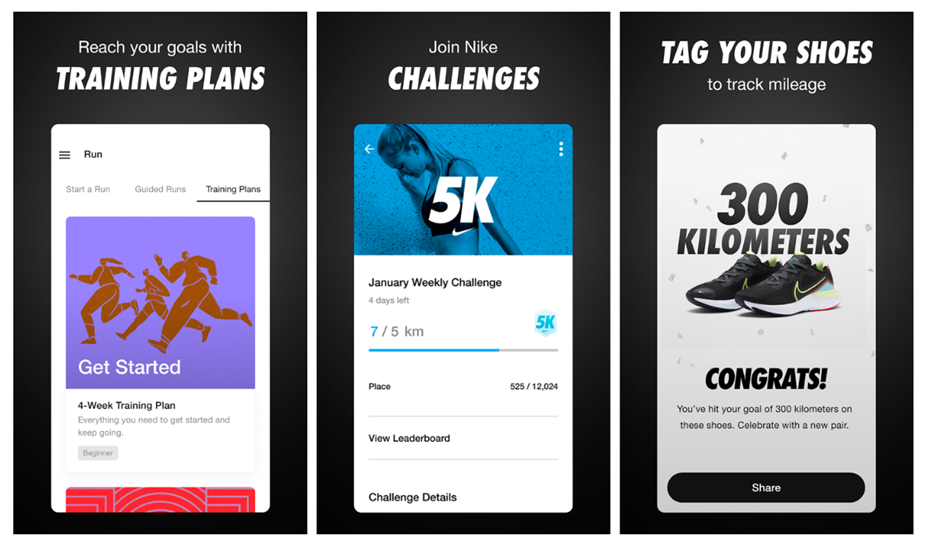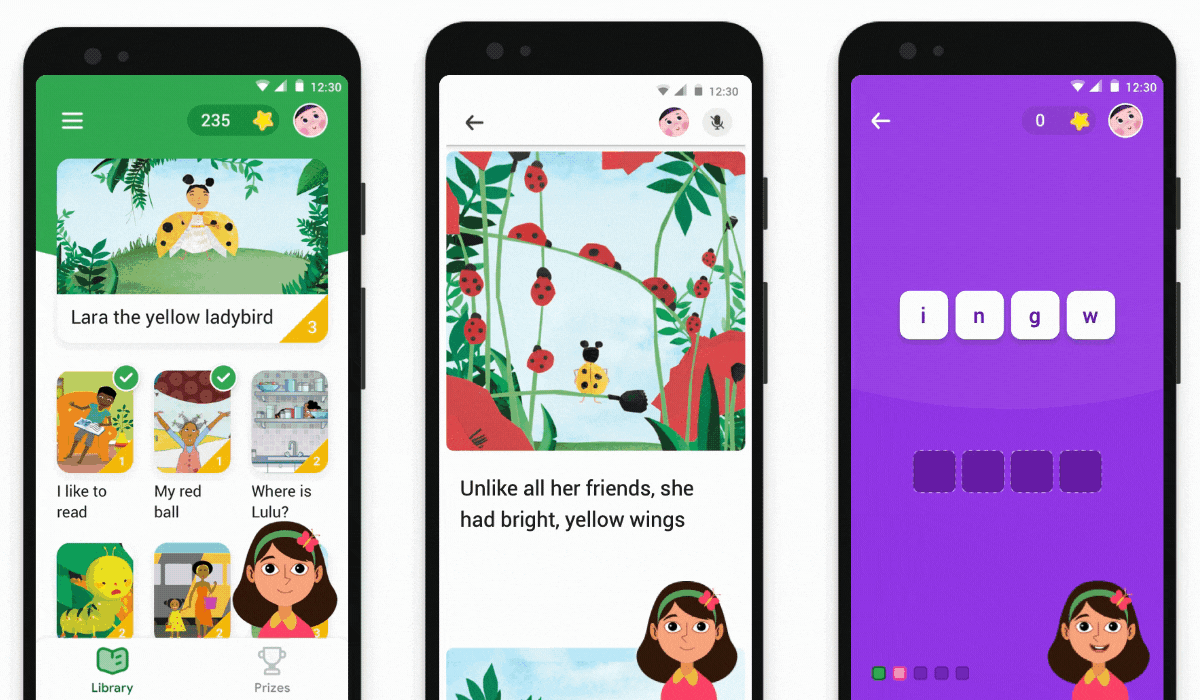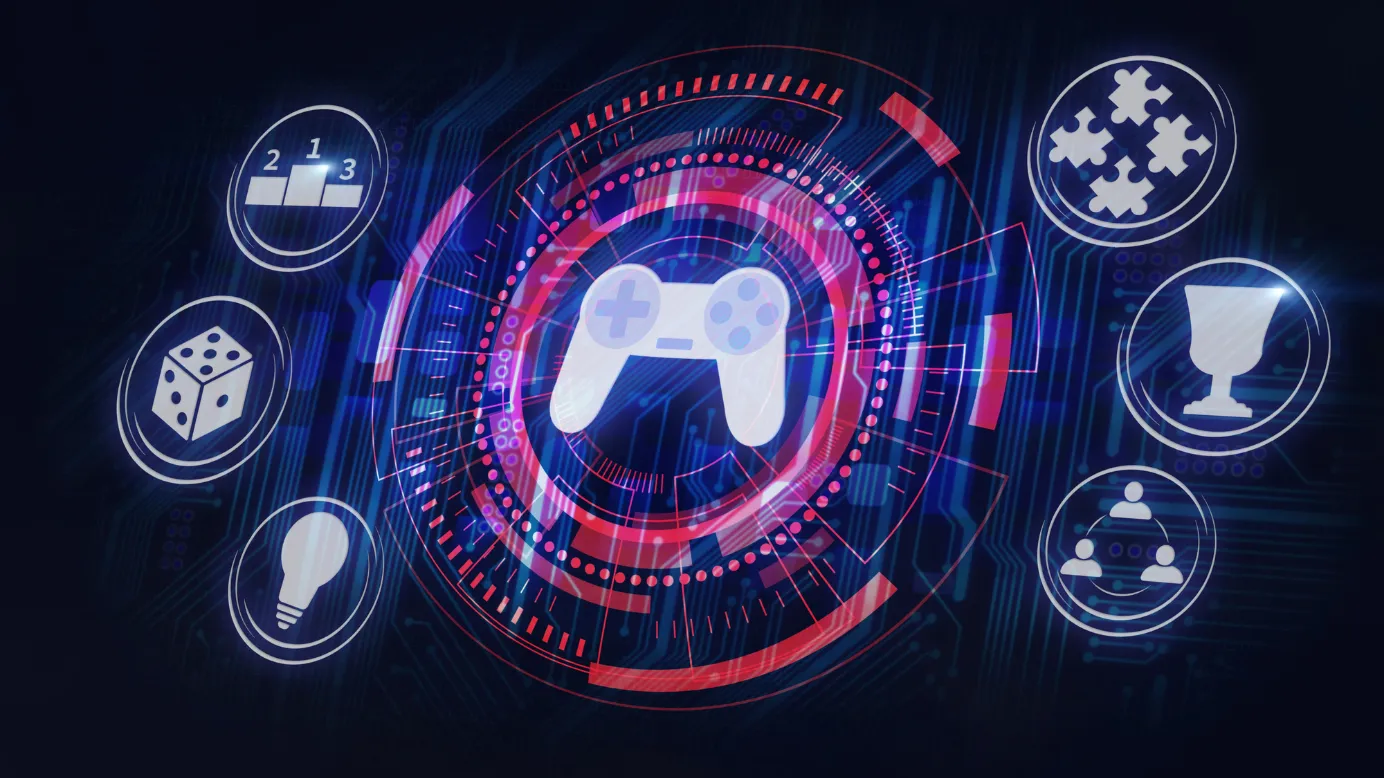Gamification des Lernens zur Verbesserung der Lernergebnisse
Was ist gamifiziertes Lernen und wie kann man das Lernen effektiv gamifizieren? Tauchen Sie ein in die Welt der Spielmechanismen wie Punkte, Bestenlisten und Herausforderungen, die langweilige Lektionen in aufregende Reisen verwandeln und das Engagement, die Motivation und die Lernergebnisse verbessern können.
Auf dieser Seite
- What is game-based learning?
- What is gamification?
- Difference between gamification and game-based learning
- Challenges with learning programs in different use-cases
- Gamification in learning
- Elements of gamification and how to use them in learning
- Schlüsselprinzipien des spielerischen Lernens
- Examples of brands using gamification & GBL (Game-Based Learning) in their applications
- How leveraging LMS integrations can save time and streamline your business
Imagine a world where every challenge earns you rewards, every task completed is applauded, and you unlock new levels just by pushing your limits. Sounds familiar? That’s the thrill of playing a game.
We’ve all experienced the joy of gaming—chasing points, clearing hurdles, and striving to win. What keeps us hooked? Three things: engagement, interest, and involvement.
When you're truly engaged, you give your best—and that energy is powerful, whether in personal growth or learning. Now, imagine applying that same game-like experience to something traditionally dull—like learning. The impact? Game-changing.
That’s the power of gamification—a proven strategy embraced by businesses, schools, and organizations to make learning and growth more exciting and effective.
Lassen Sie uns nun die Feinheiten des spielbasierten Lernens und der Gamifizierung verstehen, die Herausforderungen bei der Förderung des Engagements in Ihren Lernprogrammen, wie anreizbasiertes Lernen die Schmerzpunkte überwinden kann und vieles mehr.
What is game-based learning?
Game-based Learning (GBL) is an active learning approach that uses games to teach specific skills and achieve defined outcomes. It makes learning fun and engaging by providing a safe space to apply concepts—like stock trading simulations in economics. GBL is now widely used in corporate training to build skills in areas such as customer service, tech, and teamwork.
What is gamification?
Gamification is the process of incorporating game mechanics or elements into an overall experience to boost enjoyment or engagement. (Source: Mind Research Institute)
Bei der Gamifizierung geht es darum, Spielelemente in nicht spielerische Aktivitäten einzubauen, um ein bestimmtes Nutzerverhalten auszulösen. Gamification verwandelt einen bestimmten Lernprozess in ein Spiel. Es werden Spielelemente und Spielmechanismen verwendet, um die Lernenden zu engagieren und zu motivieren.
Interestingly, any activity can be gamified, and it isn’t just limited to learning. From fitness apps to finance platforms, gamified learning strategies are showing up everywhere.
Beispiele für Spielmechanismen sind:
- Punkte
- Belohnungen
- Leistungsabzeichen
- Fortschrittsbalken
- Bestenlisten
- Levels/Quizzes
Interestingly, any activity can be gamified, and it isn’t just limited to learning. That’s why things that you use on a day-to-day basis—from fitness apps to financial apps to your LinkedIn pages—everything is gamified to boost user participation and increase engagement.
Difference between gamification and game-based learning
While Game-Based Learning (GBL) turns the entire learning process into a game, Gamification uses games as a part of the learning process.
Organizations are increasingly adopting gamified learning to boost retention, improve performance, and make content stickier.
Der Hauptunterschied zwischen GBL (Game-Based Learning) und Gamification ist die Einbeziehung von Spielmechanismen in den Schulungsinhalt. Da GBL beides integriert, ist das Spiel eigentlich das Training selbst. Andererseits werden bei Gamification Spielelemente als Belohnungen für den Abschluss von Trainingsmodulen eingesetzt.
|
Anwendung von GBL (Game-Based Learning) |
Anwendung von Gamification |
|
In
game-based learning, learners understand new concepts and practice their
skills in a risk-free environment. Progress is directly associated with the
subject’s understanding that’s being taught. |
Gamification integrates engagement tools
with existing content to motivate learners. While adding progress bars or
levels to existing content sounds pretty straightforward, things get complex
when you place the participants on leaderboards (for example) or deliver
points whenever they give correct answers. |
|
GBL is all about making learning fun. It
has a considerable impact on learners’ recall and retention rates. Here,
users are engaged and interested in the subject matter. When there is an
increased engagement rate, it impacts retention as well. |
Gamification is all about driving
engagement. The elements of gamification work on the foundation of a human’s
need to compete, collect and succeed. |
|
GBL gives a learner the liberty to
practice or apply the skills they have learned without any real-world implications.
Users receive feedback to help them know how well they are doing and refine
their skills prior to applying them in the real-world. This is something that
LMS (Learning Management Systems) solve. |
GBL gives learners the liberty to
practice or apply the skills they have learned without any real-world
implications. Users receive feedback to help them know how well they are
doing and refine their skills before using them in the real world. This is something
that LMS (Learning Management Systems) solves. |
|
Einige Anwendungen sind: Überprüfung der Politik Ausbildung im Bereich Kundenservice Betriebliche Ausbildung Sensibilisierungsschulung für das Personal Teambildung |
Einige Anwendungen sind: Produktinnovation Einschulung Engagement für L&D-Programme Beseitigung von Mitarbeiterfehlern Kollaboratives Lernen |
Challenges with learning programs in different use-cases
Die Vorteile des engagierten Lernens sind vielfältig. Egal, ob es sich um eine Schule oder eine Organisation handelt, alle bevorzugen ein größeres Engagement, bessere Abschlussquoten, eine höhere Mitarbeiterbindung und eine größere Zufriedenheit.
Angesichts der zahlreichen Vorteile, die das Engagement der Lernenden mit sich bringt - wahrscheinlich genug, um zu überzeugen -, könnte man sich fragen, warum ein entscheidender Faktor wie "Engagement" so schwer zu erreichen ist? Der Grund dafür ist, dass einige komplexe Hindernisse der Erreichung eines höheren Engagements der Lernenden im Weg stehen.
Wir wollen die Herausforderungen von Lernprogrammen in verschiedenen Anwendungsfällen verstehen.
1. Herausforderungen, mit denen Unternehmen bei Schulungsprogrammen für ihre Mitarbeiter konfrontiert sind
When it comes to corporate training programs or L&D programs, attention isn’t enough. Sadly, the majority of L&D leaders face multiple challenges that have immediate fixes, but they fail to implement at the right time.
Im Folgenden werden einige häufige Herausforderungen von Schulungsprogrammen für Unternehmen genannt:
· One-size-fits-all approach: Forcing learners down the same path doesn’t work. Let them choose their training based on interests to meet goals faster.
· Complicated learning software: With remote training, support is limited. A user-friendly LMS with self-help tools, tutorials, and demos makes a big difference.
· Low course completion rates: Flexible training access isn't enough. What’s missing is motivation.
· Lack of engagement: Learning alone isn’t always rewarding. Offering meaningful rewards and gathering feedback boosts engagement and participation.
· Boring or irrelevant rewards: Generic or mismatched rewards (like pet vouchers for non-pet owners) can demotivate. Rewards should be personalized and location-flexible.
· No competitive elements: Without points, ranks, or peer interaction, learners lack drive. Gamification keeps motivation high.
· Delayed rewards: Gratification months later loses impact. Instant recognition through integrated reward systems ensures learners feel appreciated right away.
Instead of dull modules, gamified learning offers learners something to work toward—badges, rankings, or even rewards.
2. Herausforderungen, mit denen Lehrkräfte bei eLearning-Programmen mit Schülern konfrontiert sind
Obwohl die technologische Entwicklung viele Dinge um uns herum ermöglicht hat, die wir uns nicht hätten vorstellen können, verlief der plötzliche Wandel beim E-Learning und beim Verhalten der Schüler nach der Pandemie nicht so reibungslos, wie es sich Schulen/Lehrer/Ausbilder/Professoren/Erzieher gewünscht hatten. Die Fallstricke des Online-Lernens können sowohl für Schüler als auch für Lehrer frustrierend sein.
Hier sind einige der häufigsten Herausforderungen von Bildungs- oder E-Learning-Programmen:
· Using an outdated LMS: Today’s learners expect intuitive, modern platforms—not clunky, outdated systems. A dull LMS can disengage even the most curious students. An interactive and easy-to-navigate LMS is essential to boost participation and learning outcomes.
· Lack of motivation to learn: Students won’t learn effectively without motivation. Incorporating rewards, tokens, and appreciation for milestones adds the extra push they need to stay engaged and perform better.
· Lack of challenge or competition: Without challenges or healthy competition, learning becomes passive. Challenge-based learning fosters deeper engagement and drives students to push their limits.
· Not using a microlearning approach: Long, dense lessons can overwhelm students. Microlearning—sharing content in small, focused chunks—makes it easier to absorb information and keeps students interested.
3. Herausforderungen für Lerndienstleister mit ihrem LMS
Language service providers operate in a competitive and challenging market. Although each business is different, the challenges created by the market are similar.
Here are some challenges faced with by learning service provider:
· Unclear objectives: Launching an LMS without well-defined goals leads to delays, confusion, and unmet expectations. Before implementation, clarify your pain points, audience, and desired outcomes.
· Poor user interaction: If users don’t enjoy using the LMS, engagement drops. Provide clear onboarding and training materials to minimize friction and boost satisfaction.
· Lack of flexibility: An inflexible LMS limits scalability and integration. Third-party plugins help automate tasks, personalize learning, and ensure compliance—missing them is a missed opportunity.
· No personalization: A generic LMS fails to meet diverse learner needs. Personalization—like sending localized rewards or motivating features—is essential for engagement and effectiveness.
· No learner incentives: Without gamified rewards or challenges, learners lack motivation. Incentivized e-learning drives behavior change, but it needs a robust, scalable LMS to handle the complexity.
Gamification in learning
Ob es sich um Mitarbeiter, Kunden, Ausbilder oder Studenten handelt, Gamification dient als eine der einflussreichsten und brillantesten Strategien, um Menschen zu motivieren. Das Auslösen dieser menschlichen Wünsche mit Gamification kann die Lernerfahrung der Lernenden insgesamt anregen und verbessern.
Let's understand this with a simple example.
Assume that you are given a job to get a group of kids to do two tasks without any forceful actions:
- Task 1: Ask the kids to finish their homework
- Task 2: Ask the kids to read a book
Werden sie es tun? Nein.
Lernzeit ist überhaupt nicht unterhaltsam. Wir alle haben das als Kinder selbst erlebt. Es ist stinklangweilig. Aber nehmen wir einmal an, diese Kinder würden gebeten, Spiele zu spielen, anstatt zu lernen. Was wäre dann das Ergebnis? Sie wären bereit, die ganze Nacht lang zu spielen und dafür ihr Lieblingsessen und ihren Schlaf zu opfern, ohne sich zu beschweren. Und warum?
Nun, das liegt an der Freude, Dinge zu erleben, die viel besser und unterhaltsamer sind als das Lernen. Komponenten wie das Freischalten neuer Spielstufen und das Erreichen von Zielen im Verlauf des Spiels sind das, was sie zum Bleiben bewegt.
Now, let's say you have an option to combine gaming elements with education. What would be the result then? The same kids will be more enthusiastic about reading a book or finishing their homework willfully. That's the hidden potential of gamified learning.
Elements of gamification and how to use them in learning
Rewards, leaderboards, badges, or any other element that can motivate or satisfy a learner are called game elements.
Again, these elements are categorized into two types: Game mechanics and Game dynamics.
1. Spielmechanik
Game mechanics are used for gamifying a process (or content in the learning use-case). They help drive user behavior through points, rewards, feedback, and other types of incentives. These are the foundations for any non-gamified entity.
Die Liste der Spielmechanismen umfasst:
- Ränge und Stufen
- Spielstände und Bestenlisten
- Abzeichen und Trophäen
- Einzel- oder Teamaufgaben
- Virtuelle Währung
- Herausforderungen & Freischaltungen
- Visualisiertes Dashboard
- Avatare und individuelles Profil
2. Spiel-Dynamik
Game mechanics have the power to drive the user's motivation, but the drawback is it's only for a while. When things get repetitive users get bored again. And that’s where game dynamics play a vital role. Game dynamics amalgamates the behavior of the user with the game mechanics—helping them to evolve over time and prevent the game from being monotonous.
Die Liste der Spieldynamik umfasst:
- Zusammenarbeit
- Wettbewerb
- Fortschritt
- Errungenschaften
- Belohnungen
- Sammlung
Schlüsselprinzipien des spielerischen Lernens
Gamified Learning bietet zahlreiche Vorteile, aber sein Erfolg hängt von der richtigen Umsetzung ab. Da jede Organisation einzigartig ist, kann das, was bei einer Organisation funktioniert, bei einer anderen nicht erfolgreich sein.
Die ideale Strategie kann je nach den individuellen Bedürfnissen und Erwartungen an den Prozess sehr unterschiedlich sein. Einige wesentliche Faktoren, die bei der Entwicklung einer Gamification-Strategie zu berücksichtigen sind, werden im Folgenden aufgeführt:
- Clear and definite goals: The effectiveness of gamified learning depends on the quality of goal setting and feedback mechanisms, as indicated by a psychological study conducted by Research Gate. To achieve maximum results, expectations should be crystal clear, and feedback should remain consistent. For example, if you implement a point system, employees must fully understand the rules and the significance of earning these points. Any points awarded or withheld should come with a clear explanation as well.
- Progress tracking: It is crucial to establish an easy-to-read, transparent metric for tracking progress. Companies may choose to measure performance through different metrics like badges, points, or leaderboards to infuse a gamified appeal. Additionally, communicating the rewards of each process well in advance ensures employees understand what's at stake and helps maintain motivation.
- Challenge and competition: While fostering healthy competition among employees can make work more engaging and enjoyable, organizations must retain control of the process. Tasks and challenges should be designed with a balance in mind, making them neither too easy, nor too difficult. If competition begins to breed unhealthy rivalries or conflicts, employers must intervene swiftly to mitigate any unpleasant feelings or disputes.
- Collaboration: Promoting teamwork alongside competition can be achieved through regular team-based games. This approach enhances team relations and encourages collaborative problem-solving.
Examples of brands using gamification & GBL (Game-Based Learning) in their applications
Hier sind einige großartige Beispiele von bekannten Marken in der ganzen Welt, die nach der Anwendung von "Gamification" in ihren Anwendungen Erfolge verzeichnen konnten.
1. Nike
In 2010, Nike launched their Nike Run Club, a gamification platform, which went a massive hit among its users. The app was designed to help track and gamify a user’s run time, health levels, the distance covered, and features to compare oneself to their previous recordings or others within the social field.
Die reine Gamification hat zum Erfolg dieser App beigetragen. Sie hatten attraktive Bestenlisten, Belohnungen, Abzeichen und Punktesysteme, um das gewünschte Engagement zu fördern.

Der Run Club von Nike ist eines der klassischen Beispiele für die Mikromessung von Fortschritten und die Bereitstellung von Live-Feedback, um Läufern zu helfen, sich zu verbessern und ihre täglichen persönlichen Ziele zu erreichen.
2. Google Read Along
The recent launch of Google’s Read Along is a perfect example of how a combination of GBL (Game-Based Learning) and Gamification makes learning effective for end-users. The app was launched with an initiative to support families across the world by making ‘learning’ accessible.

Designed for kids of 5+ years old, the app uses speech recognition technology to develop literacy skills. It is available in 9 languages across 180 countries to make it more accessible. It keeps kids engaged with a diverse collection of exciting stories and interactive games sprinkled in those stories.
They can collect badges and stars as they learn, motivating them to keep reading and playing. It also helps parents to create profiles for various readers, which, when tapped, gives a dashboard showing how each one of them has progressed.
How leveraging LMS integrations can save time and streamline your business
“Seamless integrations” is a term you’ll hear often while searching for the right LMS—and for good reason. A great LMS should effortlessly connect with your existing tools, or you’ll end up with limitations and frustration.
Imagine having an LMS that can’t integrate rewards or lacks CMS connectivity. Sure, you could request custom development—but that’s costly, time-consuming, and complex.
That’s where LMS integrations become essential. They act as the engine that powers smoother operations, enhanced user experience, and smarter decisions.
Why LMS integrations are important:
- Sync effortlessly with third-party tools and APIs for maximum flexibility.
- Enable cross-platform data sharing for better learner insights and training impact.
- Save time and costs by streamlining workflows and reducing manual work.
- Support informed, scalable decisions to grow your learning ecosystem efficiently.
API integrations are the secret weapon behind smarter, faster, and more scalable eLearning and corporate training programs.
By connecting your LMS with third-party tools—like Google Analytics, CRMs, or reward platforms—you unlock time-saving automation, seamless data sharing, and effortless reporting. From auto-enrolling new hires to tracking performance in real-time, APIs help your LMS do more, with less effort.


















